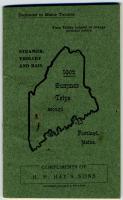Text by Chris Carney, Randy Leclair, and Doreen Rogan
Images from The Seashore Trolley Museum
Come with us as we go back in time, on a whirlwind trolley tour of 13 of the numerous trolley parks throughout Maine. Watch the balloon ascent of Roberto, Meteor of the Sky! Gasp with excitement at the thrill of horses diving 50 feet through the air into a pool of water! Kick up your heels and dance in the pavilions until 4 a.m. Above all, marvel at how cutting-edge technology came together with a thirst for adventure and forever changed social dynamics in the process.
A New Mode of Transportation
Imagine a titanic struggle between two technology companies, competing neck-and-neck for the public's favor. At the turn of the last century, the electric lightbulb was cutting-edge technology. General Electric (Thomas Edison's company) and Westinghouse (George Westinghouse and Nicola Tesla) battled fiercely over this new technology and the electricity used to power it.
At the same time, the public had limited freedom of movement, little chance to meet people even in the next town over, or to interact with people in different social or ethnic circles.
A significant outgrowth of the contest over electricity was the electric motor. Simple, powerful, and non-tiring, electric motors were welcomed by horse railways, which replaced their old horse cars with new, electric-powered, all-weather trolley cars.
Now, people were freed by a new, modern conveyance that allowed and even encouraged the elimination of social and physical barriers. The trolley car had arrived.
The "electrics" opened amazing possibilities for Maine's citizens. To these socially-diverse passengers, trolleys represented more than convenient transportation: trolleys broadened horizons. A new freedom of movement gave people new opportunities, both social and economic. Trolleys allowed people living on the outskirts of towns to commute to good paying jobs. Passengers could expect a more frequent ride, in comfort and safety. Travel times lessened, leaving room in a person's day for leisure.
For the first time, anyone could enjoy a day out of the city for the low price of a trolley fare.
For a nickel, anyone could ride; so they did, in massive numbers. Nationwide, trolley ridership peaked in 1923, with 14 billion riders annually -- among a population of 110 million. That's an average of 127 yearly trips for every man, woman, and child.
In Maine, nearly every city and many towns, from Kittery to Caribou, were served by electric railways.
A New Type of Entertainment
Trolley lines in Maine were privately owned by individuals, groups and corporations that sought the highest profit from this new technology. For the entrepreneursto capitalize on the new technology, people needed a reason to pay for a trolley ride. So the companies created the need. Electric railways began to build tourist destinations to supplement their in-town service. The new tourist destinations were located on the outskirts of towns and, significantly, in the second fare zone, doubling the companies' revenues.
During the nineteenth and early twentieth centuries, much tourism catered to wealthy Americans. In the late nineteenth century, electric railways and their new trolley parks opened tourism to other economic classes, providing opportunities for day and weekend excursions. In Maine, trolleys took mill workers, shopkeepers, farmers, and their families to the beaches, lakes and rustic resorts to enjoy some of the state's most beautiful natural resources.
Almost every electric railway in Maine had its own pleasure resort, whether it was a simple outdoor dance platform or a full-fledged hotel, complete with theater. The promise of musical entertainment, boating, bathing and other recreational activities drew crowds to Maine's trolley parks.
Day-trippers from all walks of life rode the trolleys, happily paying the very affordable double fare, which typically included admission to the park and often to the theater as well.
For $1, a young man and his best girl could ride to a park, see a show, take a spin on the dance floor, and still have enough money left over for dinner in the casino.
All aboard! Drop a dime in the fare box, find a seat inside the trolley car, and enjoy the ride to these trolley parks.








